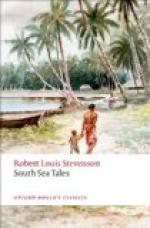CHAPTER II—FAKARAVA: AN ATOLL AT HAND
By a little before noon we were running down the coast of our destination, Fakarava: the air very light, the sea near smooth; though still we were accompanied by a continuous murmur from the beach, like the sound of a distant train. The isle is of a huge longitude, the enclosed lagoon thirty miles by ten or twelve, and the coral tow-path, which they call the land, some eighty or ninety miles by (possibly) one furlong. That part by which we sailed was all raised; the underwood excellently green, the topping wood of coco-palms continuous—a mark, if I had known it, of man’s intervention. For once more, and once more unconsciously, we were within hail of fellow-creatures, and that vacant beach was but a pistol-shot from the capital city of the archipelago. But the life of an atoll, unless it be enclosed, passes wholly on the shores of the lagoon; it is there the villages are seated, there the canoes ply and are drawn up; and the beach of the ocean is a place accursed and deserted, the fit scene only for wizardry and shipwreck, and in the native belief a haunting ground of murderous spectres.
By and by we might perceive a breach in the low barrier; the woods ceased; a glittering point ran into the sea, tipped with an emerald shoal the mark of entrance. As we drew near we met a little run of sea—the private sea of the lagoon having there its origin and end, and here, in the jaws of the gateway, trying vain conclusions with the more majestic heave of the Pacific. The Casco scarce avowed a shock; but there are times and circumstances when these harbour mouths of inland basins vomit floods, deflecting, burying, and dismasting ships. For, conceive a lagoon perfectly sealed but in the one point, and that of merely navigable width; conceive the tide and wind to have heaped for hours together in that coral fold a superfluity of waters, and the tide to change and the wind fall— the open sluice of some great reservoirs at home will give an image of the unstemmable effluxion.




